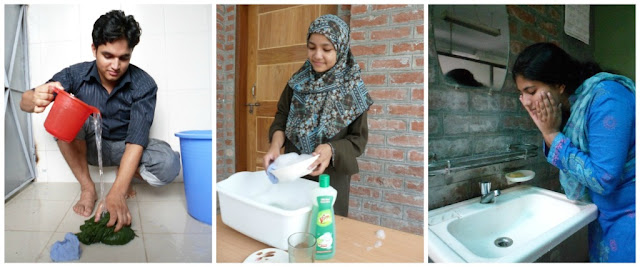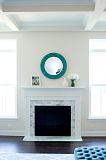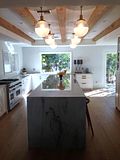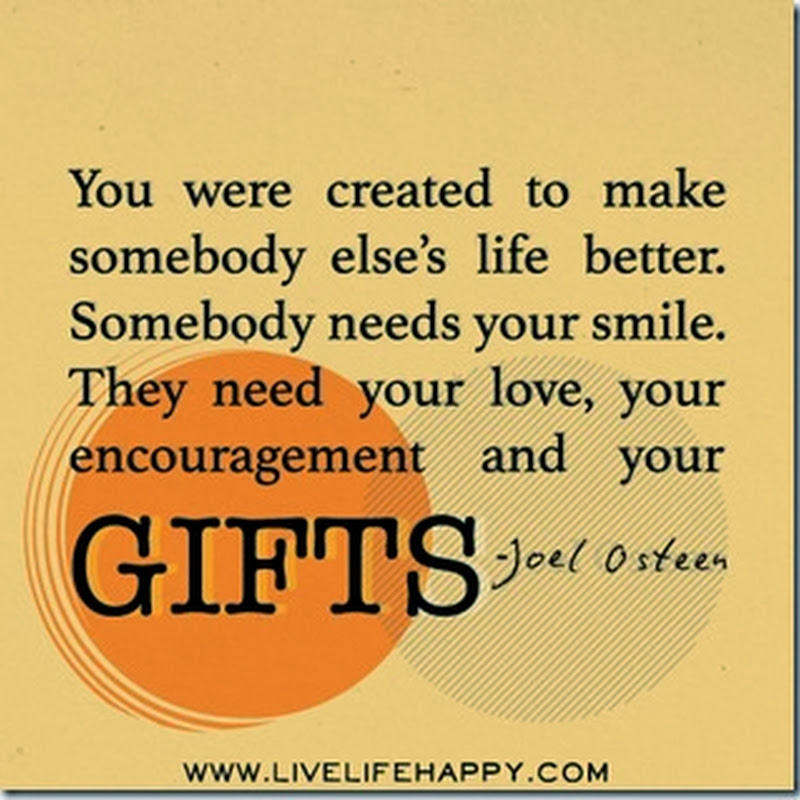Before I leave the topic of Bangladesh I thought some of you might be interested to know a bit more about what my friend Kim and I did when we were at the Centre for the Rehabilitation of the Paralysed (CRP) in Savar. We were there for 4 1/2 weeks and in that time we packed in a lot of different projects. Before we left home we knew what courses we would be teaching, but apart from that we had no idea of how else we could help, so the other projects we undertook were ones we identified after we arrived.
Kim taught a course in Adult Neurogenics (speech problems resulting from stroke, Parkinson's disease, and the like). I taught a course in Autism and Developmental Delays and half of the Introduction to Speech Therapy course. While it might appear that I did more work than Kim, her course was 18 lecture hours a week and my courses totaled 16 lecture hours a week. We taught in English (obviously, since our Bangla isn't too hot), which did cause some difficulties, but not insurmountable ones. We had to remember to speak slowly, and often we had to repeat information, and use lots of examples.
One of the projects I was most excited about was the photo therapy cards I had my first year class make. When we got to Bangladesh we found that the clinic had very few pictures for use in therapy. Here was an opportunity to make culturally relevant materials for instructional use. Kim and I had taken two point-and-shoot cameras with us to donate to the department so I had them available for my first year class to use to take photos of each other. I gave my class a half-hour talk about how to take good photographs and then I divided them into five groups. They took pictures that illustrated common verbs, common prepositions (location words), and common objects. In order to get all the photos, some groups went out to the shops and around CRP to take pictures.
The first two groups took pictures of twenty common verbs, like "playing", "jumping", "running", and "shopping". We wanted them to be able to use the cards to make a variety of sentences, so they photographed each verb being done by a male student, a female student, and a group of students. You can see one of the series in the photos below:
Another group took pictures of five common verbs, each with three different objects, so that they could use the photographs to extend sentences; for example: "eating biscuits", "eating rice", and "eating an apple". When it came to photographing "eating" and "drinking" the students were good sports. As it was Ramadan and the students were fasting they could only put the food and drink near their mouths. I felt bad to have them so near refreshment when they must have been pining for a bite to eat or to take a sip, but there was no other time we could do this project, so my brave students soldiered on.
Another group took photos of prepositions. One of my favourites was this series of photos taken around a rickshaw.
The fifth group took photos of thirty common objects. These were for use by people who are unable to talk because of a stroke or some other problem and could use the pictures to request things. Below are a few of the objects that are somewhat unique to Bangladesh.
We had the photos printed in duplicate so that the cards could be used for matching or playing memory games. We also had the cards laminated so they would last. Finally, I put the photos on an external hard-drive so that if they get spoiled they can be reprinted. Therapists might also want to make a communication board for a patient from these files, or they might wish to extend the collection.
I have to tell you about one of the funny moments that occurred while we were working on this project. During the "washing" series, I asked the students where they wash dishes. "In a basin, Ma'am". So a basin it was. Then I asked if they also wash clothes in a basin. "No Ma'am". Do you use a sink, I asked. But this was not correct either. Where do you wash clothes, I asked. "In the "toilet"! Fortunately one of the students added, "On the floor in the toilet". So off the group went to find a toilet so they could take pictures of clothes washing. When they came back and I looked at the photos, I noticed they had washed the blue dish cloth Kim and I used in our kitchen (see the photo above)! YUCK, YUCK AND TRIPLE YUCK. Dish cloths being in short supply, I boiled it for five minutes before we used it again.

Another project we did at CRP was to develop a stroke patient language-skills screening test, which Kim had her third students produce, in Bangla. Now CRP has a complete aphasia screening test, ready for use by future instructors and students (the white binder in the photo above).
Thanks for your patience in reading about these projects. Just one more! I had my first year students collect magazine pictures - which they did in abundance. Then Kim organized them into three binders: one for pictures that show emotions; one for pictures that show actions; and one for pictures that tell a story (the blue binders in the photo above). Not only was this a low-cost way to obtain therapy materials, but the pictures are all culturally-relevant since they show people from Bangladesh.
Maybe shopping is more in the category of "fun" than "project", but in any case Kim and I went on a buying spree for the department, for children's books, toys, and magazine file boxes to organize the tests.
In Dhaka we purchased a series of books made in Bangladesh that illustrate common vocabulary items. The books were only a couple of dollars each so we bought three copies of each - one to keep whole and two to cut up to make vocabulary items that can be matched and sorted. You can see the books in the next photo in their plastic pouches:

Kim taught a course in Adult Neurogenics (speech problems resulting from stroke, Parkinson's disease, and the like). I taught a course in Autism and Developmental Delays and half of the Introduction to Speech Therapy course. While it might appear that I did more work than Kim, her course was 18 lecture hours a week and my courses totaled 16 lecture hours a week. We taught in English (obviously, since our Bangla isn't too hot), which did cause some difficulties, but not insurmountable ones. We had to remember to speak slowly, and often we had to repeat information, and use lots of examples.
 |
| Teaching the Autism and Developmental Delay course to third year students |
 |
| My first year students outside our classroom |
One of the projects I was most excited about was the photo therapy cards I had my first year class make. When we got to Bangladesh we found that the clinic had very few pictures for use in therapy. Here was an opportunity to make culturally relevant materials for instructional use. Kim and I had taken two point-and-shoot cameras with us to donate to the department so I had them available for my first year class to use to take photos of each other. I gave my class a half-hour talk about how to take good photographs and then I divided them into five groups. They took pictures that illustrated common verbs, common prepositions (location words), and common objects. In order to get all the photos, some groups went out to the shops and around CRP to take pictures.
 |
| Taking pictures to make therapy cards. Foreground: taking pictures of "playing". Background: setting up pictures for "washing" |
The first two groups took pictures of twenty common verbs, like "playing", "jumping", "running", and "shopping". We wanted them to be able to use the cards to make a variety of sentences, so they photographed each verb being done by a male student, a female student, and a group of students. You can see one of the series in the photos below:
 |
| Picture series to show "They are shopping", "She is shopping", and "He is shopping" |
Another group took pictures of five common verbs, each with three different objects, so that they could use the photographs to extend sentences; for example: "eating biscuits", "eating rice", and "eating an apple". When it came to photographing "eating" and "drinking" the students were good sports. As it was Ramadan and the students were fasting they could only put the food and drink near their mouths. I felt bad to have them so near refreshment when they must have been pining for a bite to eat or to take a sip, but there was no other time we could do this project, so my brave students soldiered on.
 |
| Pictures to show "He is washing clothes", "She is washing dishes", and "She is washing her face" |
Another group took photos of prepositions. One of my favourites was this series of photos taken around a rickshaw.
 |
| Photos to show "behind", "in", "in front of", "on", "beside", and "under" |
The fifth group took photos of thirty common objects. These were for use by people who are unable to talk because of a stroke or some other problem and could use the pictures to request things. Below are a few of the objects that are somewhat unique to Bangladesh.
 |
| Left to right: Lunghi (wrap worn by men); salwar kameez (worn by women); mosquito net; wheelchair (made at CRP) |
We had the photos printed in duplicate so that the cards could be used for matching or playing memory games. We also had the cards laminated so they would last. Finally, I put the photos on an external hard-drive so that if they get spoiled they can be reprinted. Therapists might also want to make a communication board for a patient from these files, or they might wish to extend the collection.
 |
| Therapy photo cards, in duplicate and laminated - ready for use! |
I have to tell you about one of the funny moments that occurred while we were working on this project. During the "washing" series, I asked the students where they wash dishes. "In a basin, Ma'am". So a basin it was. Then I asked if they also wash clothes in a basin. "No Ma'am". Do you use a sink, I asked. But this was not correct either. Where do you wash clothes, I asked. "In the "toilet"! Fortunately one of the students added, "On the floor in the toilet". So off the group went to find a toilet so they could take pictures of clothes washing. When they came back and I looked at the photos, I noticed they had washed the blue dish cloth Kim and I used in our kitchen (see the photo above)! YUCK, YUCK AND TRIPLE YUCK. Dish cloths being in short supply, I boiled it for five minutes before we used it again.

Another project we did at CRP was to develop a stroke patient language-skills screening test, which Kim had her third students produce, in Bangla. Now CRP has a complete aphasia screening test, ready for use by future instructors and students (the white binder in the photo above).
Thanks for your patience in reading about these projects. Just one more! I had my first year students collect magazine pictures - which they did in abundance. Then Kim organized them into three binders: one for pictures that show emotions; one for pictures that show actions; and one for pictures that tell a story (the blue binders in the photo above). Not only was this a low-cost way to obtain therapy materials, but the pictures are all culturally-relevant since they show people from Bangladesh.
 |
| Kim and I displaying the magazine picture binders to the students |
Maybe shopping is more in the category of "fun" than "project", but in any case Kim and I went on a buying spree for the department, for children's books, toys, and magazine file boxes to organize the tests.
 |
| Shopping for children's books and anatomy charts for the walls in the clinic |
In Dhaka we purchased a series of books made in Bangladesh that illustrate common vocabulary items. The books were only a couple of dollars each so we bought three copies of each - one to keep whole and two to cut up to make vocabulary items that can be matched and sorted. You can see the books in the next photo in their plastic pouches:
 |
| Kim and I and some interns and fourth year students admire the materials we bought in Dhaka or brought over with us |
 |
| Kim used the magazine file boxes to organize the tests And finally, on the last day, Kim and I held a therapy materials demonstration to show the students how to use the photos, magazine pictures, aphasia screening test, books, and toys. My mantra was that I wanted them to make therapy fun so that their patients would want to "learn and return". |




















































































































































































.jpg)



















































































.jpg)



























Everything is just brilliant. What a great contribution you made.!
ReplyDeleteThis is so fascinating! You must feel such a sense of fulfillment having accomplished so many projects that will help them become better therapists. It's interesting to see so many men in the classes since there are very few here in the states (such a female dominated profession here and I'm assuming Canada too?). I also have to comment that I love that there was no mention of "speech" and the focus was on neuro and language. People here may find that interesting since most associate SLPs with speech only disorders. I love learning about cultural diversity and appreciate the cultural differences among us but washing clothes in the toilet is a little too different for me. Great post about an awesome experience!!!
ReplyDeleteBlessings to you, Grace. Your work there will impact so many people. I am so proud of you! Thanks so much for sharing your photos and stories with us. You accomplished so much in such a short amount of time! *awesome*
ReplyDeletexoxoxoxo,
Ricki Jill
Great job! I am sure they will remember your work for a long time.
ReplyDeleteI enjoyed reading this very interesting post about your work. I'm sure there will be so many people that will benefit. You must have a great sense of accomplishment.
ReplyDelete